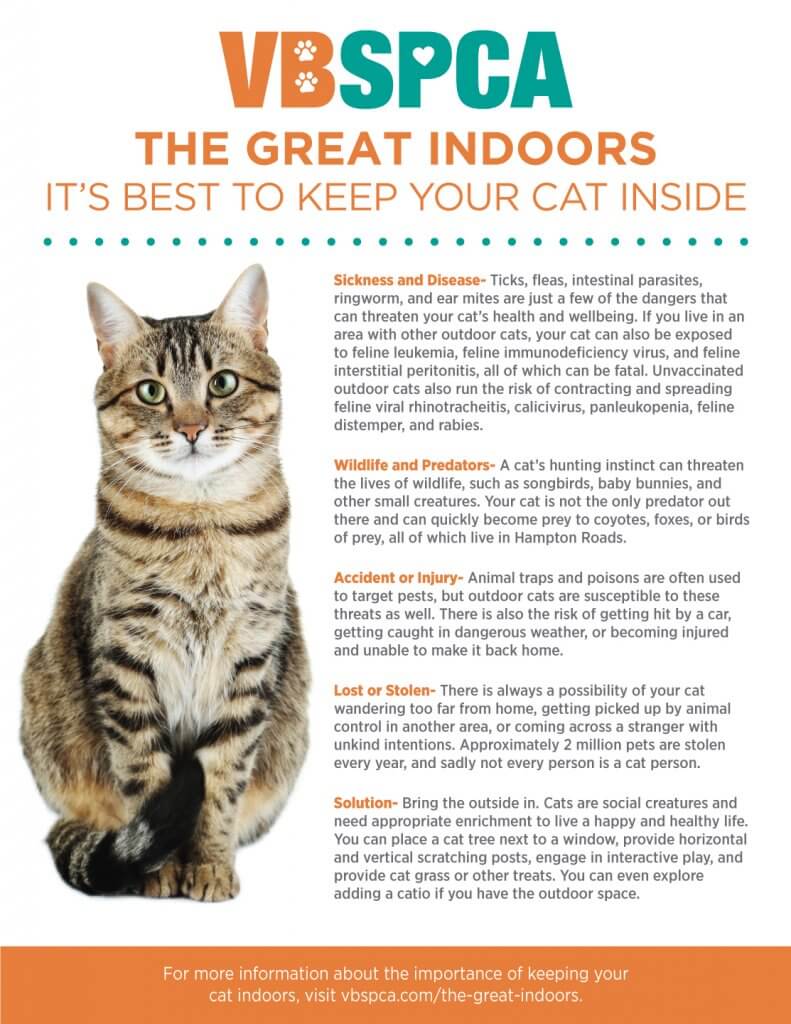Cats are natural hunters. They’ve evolved from helping control pests on ships and farms to slowly becoming domesticated companions in our homes. Domesticated cats exercise their hunting instincts through play, finding food in the bowls we fill for them, chasing red lasers, or sneaking up on your ankles from across the room. However, as much as they pounce and play, cats also embody a sense of independence that is quite the opposite of their canine counterparts. But this air of independence can be misleading, because domesticated cats rely on us for their safety and wellbeing, despite their self-sufficient stereotype.
Help practice responsible pet ownership by keeping your cat indoors and not allowing your cat to roam outside. You may feel that a life inside is too restrictive for your little hunter, but indoor cats can live up to 6 times longer than outdoor cats, which makes keeping your cat indoors the best choice if you want to share a long life with your feline friend.
Not convinced? Here are a few more reasons why living indoors is a a safer and healthier option for your cat.
Sickness and disease.
Indoor cats are not exposed to parasites and other communicable diseases to which outdoor cats are susceptible. Ticks, fleas, intestinal parasites, ringworm, and ear mites are just a few of the dangers that can threaten your cat’s health and wellbeing. However, these dangers don’t just threaten your cat, your cat’s exposure to them can threaten other animals in your home, including you. If you live in an area with other outdoor cats, your cat can be exposed to the many contagious diseases among felines, such as feline leukemia (FeLV), feline immunodeficiency virus (FIV), and feline interstitial peritonitis (FIP), all of which can be fatal. Unvaccinated outdoor cats also run the risk of contracting and spreading feline viral rhinotracheitis (herpesvirus), calicivirus, panleukopenia, or feline distemper. And that’s just between cats. Other animals outdoor cats will come across exposes them to many more diseases and deadly viruses, like rabies.
Wildlife and Predators.
A cat’s hunting instinct can threaten the lives of wildlife, such as songbirds, baby bunnies, and other small creatures. As proud as your cat may be to have captured her prey, you may not be as thrilled to receive these special “gifts.” Furthermore, interactions with local wildlife can also risk injury and infection, which may not be easy to spot right away. Plus, your cat is not the only predator out there and can quickly become prey to coyotes, foxes, or birds of prey, all of which live in Hampton Roads.
Accident or Injury.
Animal traps and poisons are often used to target pests, but outdoor cats are susceptible to these threats as well. There is also the risk of getting hit by a car, which can happen in both urban areas and on country roads. A free roaming cat can also get caught in dangerous weather conditions, access poison or toxic substances, or become injured and physically unable to make it back home.
Lost or Stolen.
No matter how “street-smart” your cat may be, there is always a possibility of your cat wandering too far from home, getting picked up by animal control in another area, or coming across a stranger with unkind intentions. Approximately 2 million pets are stolen every year, and sadly not every person is a cat person.
Solution: Bring the outside in
Cats are still social creatures and need appropriate enrichment to live a happy and healthy life. Here are a few things you can do to make sure your cat is getting the enrichment needed to be safe and happy.
- Put a cat tree by a window so they can view the great outdoors while remaining safely inside.
- Create multiple levels of perches for jumping and exercising inside.
- Set up a spot with cat grass and other treats, as well as different textures for your cat to enjoy.
- Use both horizontal and vertical cat scratchers.
- Engage in interactive play using wands and laser toys as a wonderful way to provide the mental and physical exercise your cat needs. Interactive play is also a great method for redirection if your cat seems too focused on going outside.
- Use puzzle toys, so your cat can treasure hunt for treats.
If your cat absolutely needs time outside, consider a “catio” or secure outdoor enclosure. If you don’t have the time or space for a catio, you can take steps to get your cat used to a harness and take your cat on a walk!


Last Updated: February 23, 2021 by vbspcaadmin
The Great Indoors
Cats are natural hunters. They’ve evolved from helping control pests on ships and farms to slowly becoming domesticated companions in our homes. Domesticated cats exercise their hunting instincts through play, finding food in the bowls we fill for them, chasing red lasers, or sneaking up on your ankles from across the room. However, as much as they pounce and play, cats also embody a sense of independence that is quite the opposite of their canine counterparts. But this air of independence can be misleading, because domesticated cats rely on us for their safety and wellbeing, despite their self-sufficient stereotype.
Help practice responsible pet ownership by keeping your cat indoors and not allowing your cat to roam outside. You may feel that a life inside is too restrictive for your little hunter, but indoor cats can live up to 6 times longer than outdoor cats, which makes keeping your cat indoors the best choice if you want to share a long life with your feline friend.
Not convinced? Here are a few more reasons why living indoors is a a safer and healthier option for your cat.
Sickness and disease.
Indoor cats are not exposed to parasites and other communicable diseases to which outdoor cats are susceptible. Ticks, fleas, intestinal parasites, ringworm, and ear mites are just a few of the dangers that can threaten your cat’s health and wellbeing. However, these dangers don’t just threaten your cat, your cat’s exposure to them can threaten other animals in your home, including you. If you live in an area with other outdoor cats, your cat can be exposed to the many contagious diseases among felines, such as feline leukemia (FeLV), feline immunodeficiency virus (FIV), and feline interstitial peritonitis (FIP), all of which can be fatal. Unvaccinated outdoor cats also run the risk of contracting and spreading feline viral rhinotracheitis (herpesvirus), calicivirus, panleukopenia, or feline distemper. And that’s just between cats. Other animals outdoor cats will come across exposes them to many more diseases and deadly viruses, like rabies.
Wildlife and Predators.
A cat’s hunting instinct can threaten the lives of wildlife, such as songbirds, baby bunnies, and other small creatures. As proud as your cat may be to have captured her prey, you may not be as thrilled to receive these special “gifts.” Furthermore, interactions with local wildlife can also risk injury and infection, which may not be easy to spot right away. Plus, your cat is not the only predator out there and can quickly become prey to coyotes, foxes, or birds of prey, all of which live in Hampton Roads.
Accident or Injury.
Animal traps and poisons are often used to target pests, but outdoor cats are susceptible to these threats as well. There is also the risk of getting hit by a car, which can happen in both urban areas and on country roads. A free roaming cat can also get caught in dangerous weather conditions, access poison or toxic substances, or become injured and physically unable to make it back home.
Lost or Stolen.
No matter how “street-smart” your cat may be, there is always a possibility of your cat wandering too far from home, getting picked up by animal control in another area, or coming across a stranger with unkind intentions. Approximately 2 million pets are stolen every year, and sadly not every person is a cat person.
Solution: Bring the outside in
Cats are still social creatures and need appropriate enrichment to live a happy and healthy life. Here are a few things you can do to make sure your cat is getting the enrichment needed to be safe and happy.
If your cat absolutely needs time outside, consider a “catio” or secure outdoor enclosure. If you don’t have the time or space for a catio, you can take steps to get your cat used to a harness and take your cat on a walk!
Category: VBSPCA News Tags: Cats, Indoor, Indoor Cats
Search
Recent Posts
Topics